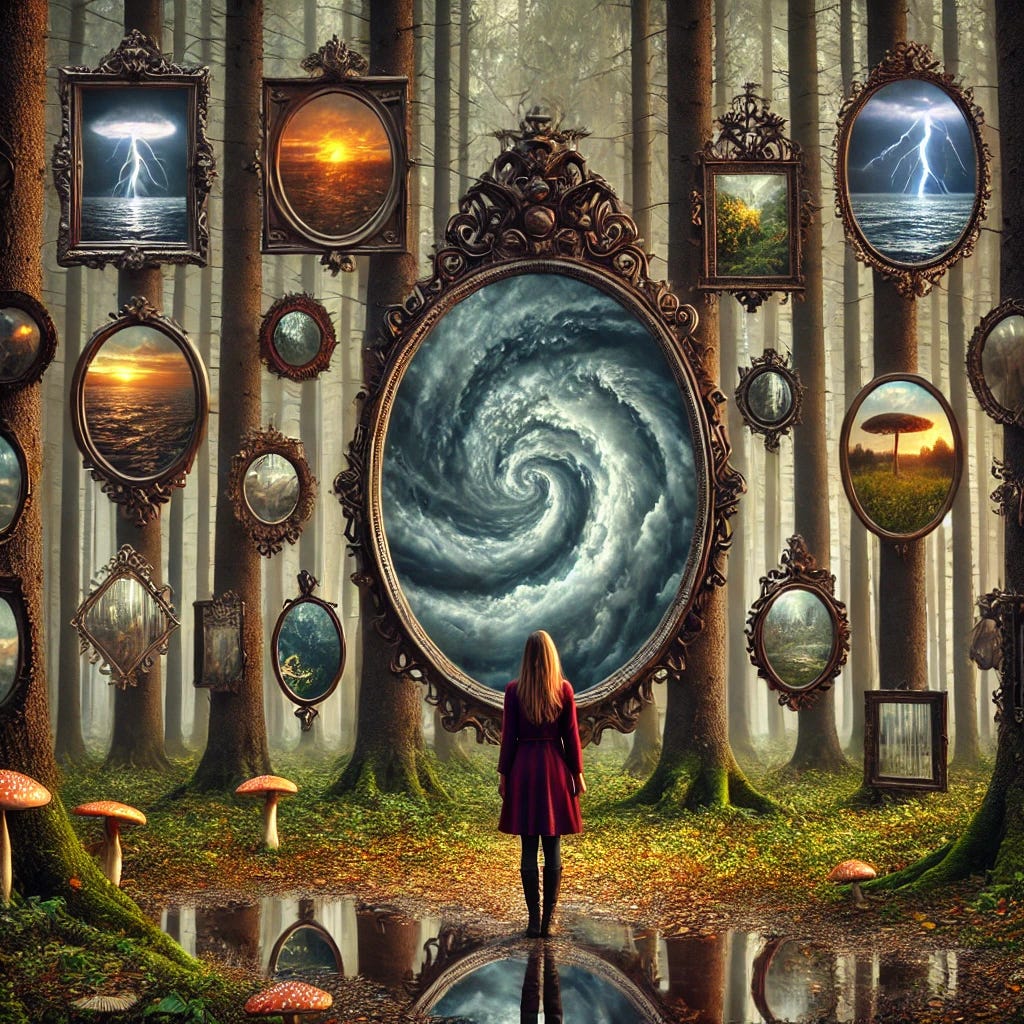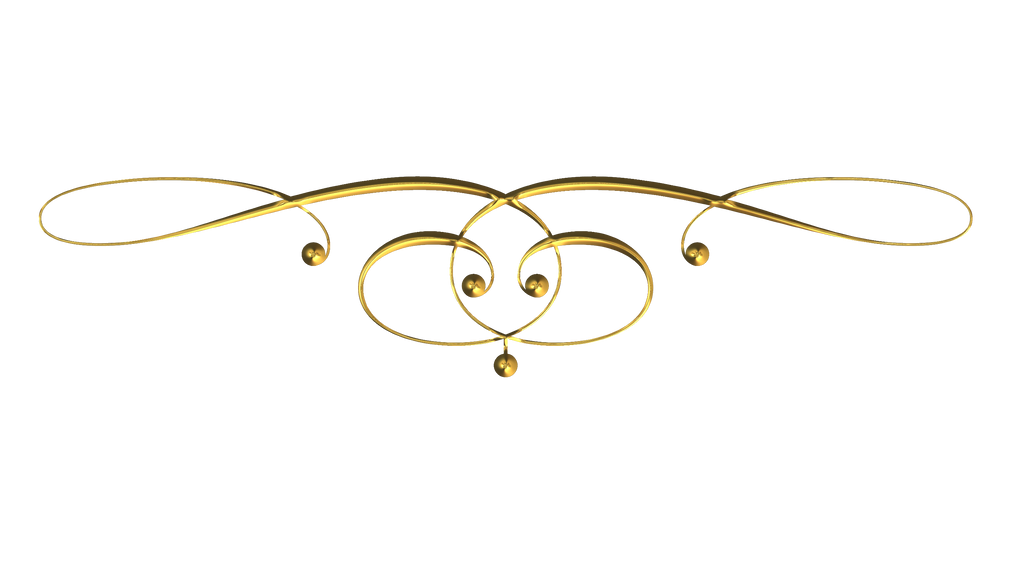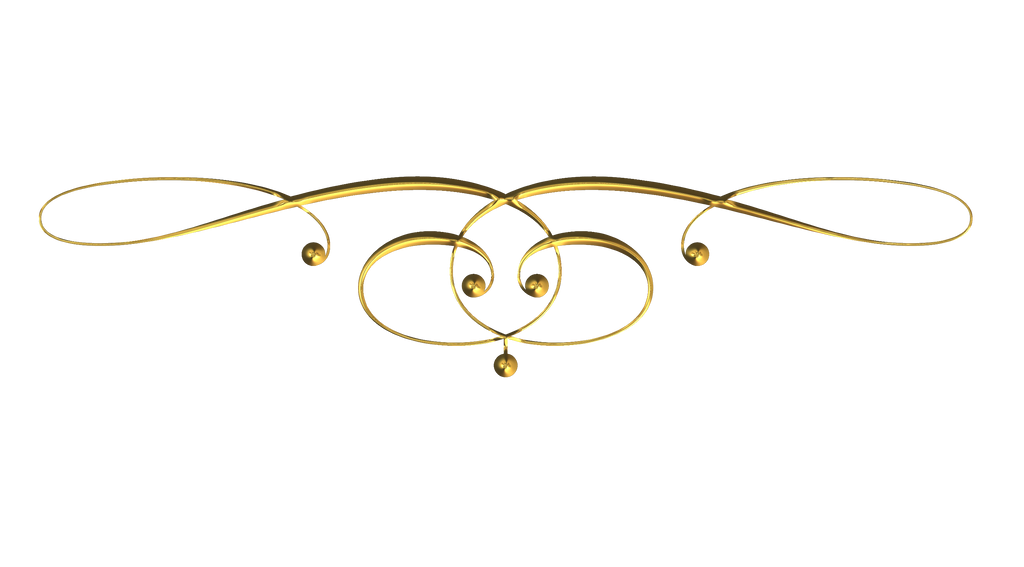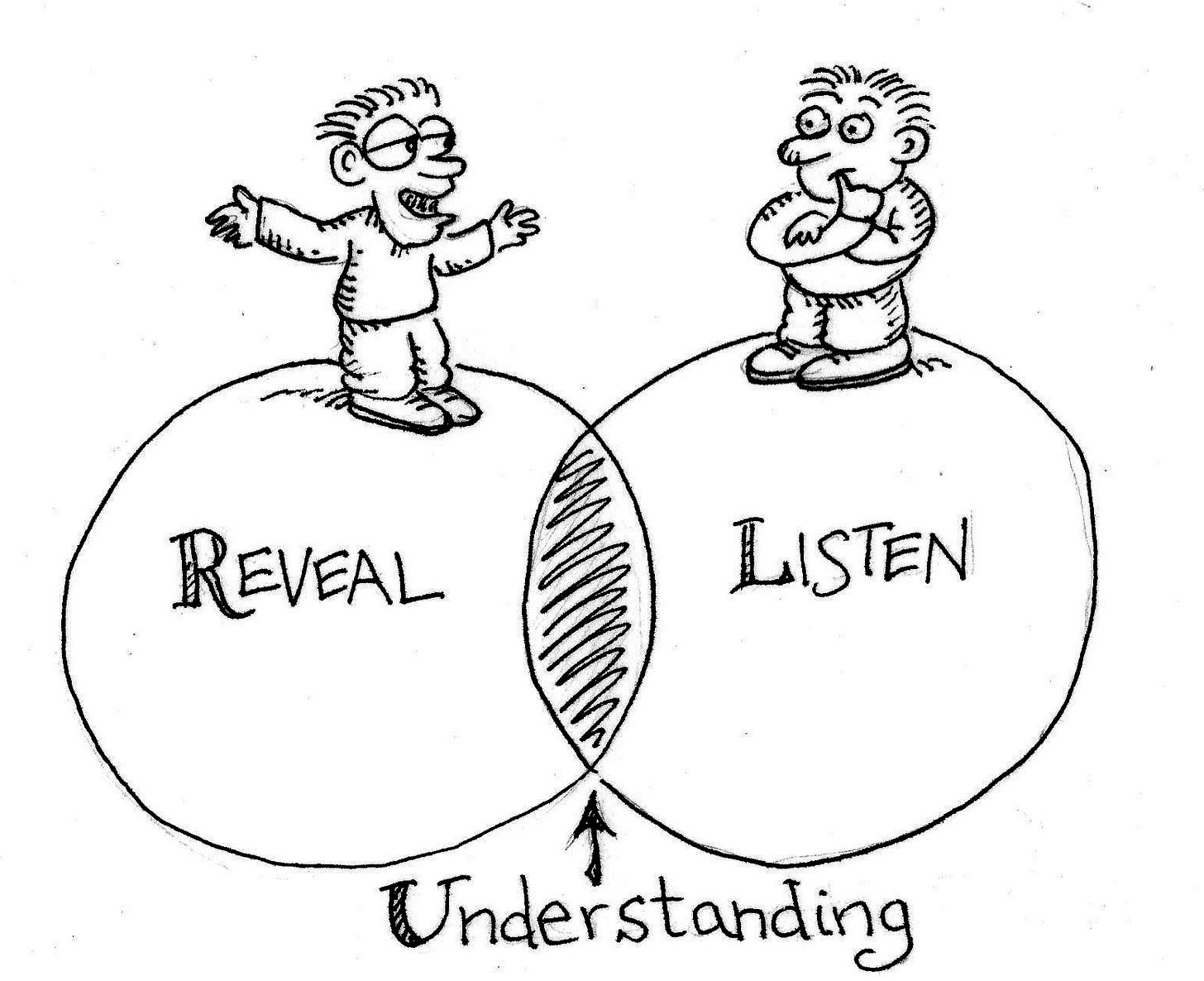Part 2 - Maya and The Forest of Mirrors: A Parable on How Reflections Can Deceive
Applying practical parable insights to real life situations while unraveling the illusions we choose to believe with certainty
Last week, I shared this parable alone. This week, I share the parable once again as a refresher, followed by some musings. At the very bottom of this post, I provide a deeper dive for insights using the parable for self-excavation.
Maya and The Forest of Mirrors
In a quiet village nestled between two towering mountains, there lived a group of people who prided themselves on believing they knew “the truth” about everything.
Their village was surrounded by a mystical forest filled with mirrors that reflected, not only the physical world, but the deepest fears, desires, and beliefs of those who looked into them. Each mirror reflected a different version of reality, causing villagers to cling tightly and comfortably to their chosen reflections, believing theirs was the only "true" version.
One day, a young woman named Maya ventured into the forest after hearing whispers of a new mirror that was said to show something unexpected—something beyond the villagers' understanding. As she approached the mirror, she found herself confronted -not by her reflection- but by an image of swirling clouds, lightning bolts, and devastation. The scene was chaotic, unsettling, and utterly unfamiliar.
Curious but cautious, Maya remembered the wise teachings of non-attachment she had learned from her travels to the east, beyond the village. She did not let fear or confusion cloud her mind, but instead, she simply observed.
"What if these strange scenes are true?…And what if they’re aren’t?" she mused to herself, leaving the vision to rest in suspended animation in her mind. She wasn’t ready to make a judgment about it but was willing to hold space for the unknown.
Days passed, and the villagers grew anxious. "What did you see?" they anxiously asked her. "What does the mirror reveal?" Some were quite eager to dismiss her tale before she even told it, while others faithfully clung to it, believing it to be “the truth” that foretold disaster.
But Maya remained calm.
"I don’t know if it’s true or not," she said with a gentle smile, "but what I learned is that the mirror doesn’t just show reality as we know it—it shows possibilities, things that we may not yet understand. Instead of being afraid or certain, I’m going to stay calm and curious to see what unfolds."
Her words were met with confusion with some scoffing at her seeming indecision, while others found comfort in her openness. As time went on, life’s storms came and went. Some resembled the images in the mirror, while others did not. Still, Maya's approach allowed her to navigate the uncertainty with grace.
In time, others in the village began to visit the forest, peeking into the mirrors without trepidation or judgment, just like Maya did. Some began to learn to sit with the discomfort in the void of uncertainty not knowing what the mirror was showing.
Slowly, more people learned to sit in their discomfort of not knowing the “true” answer. Over time, the village grew more peaceful and less divided as fighting about competing "truths" lessened as they became more comfortable not knowing what “the truth” might actually be.
Maya's wisdom resonated with them. Sometimes, the most important knowledge isn't necessarily found in certainty, but in the ability to observe without judgment, to let possibilities swirl until clarity comes…or doesn’t.
Either way, it was the journey—not the final answer—that held the key to true understanding.
*~*~*~*
For those that may not be aware, Maya means “illusion”.
The digital mirrors in our screens
In today's world, computers, phones, and televisions act as mirrors reflecting our beliefs. Whether it's the curated feeds on social media, news channels that cater to our political leanings, or even the shows we choose to binge-watch, these screens often reinforce what we already think and feel.
As shown in the documentary film The Social Dilemma, they reflect back our own views and desires, shaped and amplified by algorithms. Just like the villagers in the parable, we often subconsciously cling to these reflections, believing they represent the full truth.
Our computers that were once viewed as windows into the world, have increasingly become mirrors that we now carry in our pockets. These digital mirrors often show us what we want to see, reinforcing our perceptions causing us to mistake these reflections for “truth”.
Much like the mirrors in the forest, they feed us familiar images, keeping us comfortably within the boundaries of our own views rather than opening our eyes to the broader world.
What we see through screens isn't necessarily an accurate representation of reality but often a reflection of our own mental and emotional landscape.
It’s best that we don’t put 100% trust in our screens because they mislead; even worse, they can lie.

Keep these insights in mind regardless of which party gets into office
The political landscape is often a battleground of competing ideologies, where it can be tempting to see things in black and white—"right" or "wrong," "us" vs. "them." However, by embracing the lessons of curiosity, non-attachment, and humility, we can rise above and transcend the divisiveness that political systems tend to magnify, but we have to have the desire to do so.
Whether our preferred party wins or loses, these takeaways can serve as a personal compass of intention, helping us to stay grounded in a time of great change, uncertainty, and tension. That doesn’t mean that we have to be happy with how it turns out if our party loses. It merely means that we continue to stand for and support what feels right to us while not attacking others personally for their different views. Make it more about the issues and less about the personalities.
These concepts are paramount for individual and collective peace moving forward
As politics tends to fuel polarization, holding onto the idea that no one perspective holds the entire truth encourages understanding and reduces conflict. By fostering an open-minded, non-judgmental approach, we allow room for dialogue and bridge-building, which are key to fostering societal harmony.
Political leaders and policies may come and go, but cultivating peace and empathy at the individual level can ripple out into communities, leading to greater collective stability.
I’m starting with the wo(man) in the mirror
I know. Some of you have absolutely no desire to try to engage in good faith dialogue or build bridges with “them”. While I can understand, this makes you part of the larger problem. I hope you’ll work on that. We need more stability and less conflict because what we’re doing isn’t sustainable nor good for us long term.
Be the change you wish to see in the world
Rather than feeding into the cycle of negativity, fear, and conflict that often surrounds political discourse and other issues, choosing to embody these concepts—curiosity, patience, humility, and non-attachment—creates a ripple effect of positive change.
When we model the behavior we want to see in others, we influence our immediate environment. Instead of exacerbating the problem by reacting with anger, judgment, or frustration, we become a stabilizing force that promotes thoughtful dialogue, mutual respect, and shared understanding.
In an era where algorithms amplify outrage and disagreements, remaining calm, compassionate, and open to others’ perspectives, even when they differ from our own, is an act of leadership making us part of the solution instead of part of the problem. It's through these individual choices that we can begin to heal divisions and contribute to a more peaceful, unified society.
At the end of the day, lasting change doesn’t come from political figures or parties—it comes from how we treat each other in our daily lives and it’s important that we go first.
Are you aggravated by what you’ve read? Notice that.
Some of you are likely pissed off by this point because you think that I’m naive about the ignorance or evil on “the other side”. I can assure you that’s not true. I’m merely asking us to work around what we think we know about the other side and dig deeper. If we do what we’ve always done, we’ll get what we’ve always got. What we’re doing definitely isn’t working so we need to try something new. We need more heart activation which tamps down anger to get through this.
Ask Alecia Video: There are so many things out there that it's hard to be sure about anything anymore. So what do we do when we're unsure? We give ourselves permission to stay in that space until we get it figured out. There's no reason to jump into an opinion about things when we're really unsure. Doing so merely makes things worse because it just accelerates and adds to the conflict of everyone thinking that they're the only ones with the "right" answers.
In closing
I hope you’ll bring good energy to the world by playing your part in neutralizing this polarization that we find ourselves in. By choosing to rise above division, we create the conditions for individual peace and a more harmonious collective future.
Are you ready to join Maya and I in the forest of mirrors? You can dive deeper with the concepts below.
A deeper dive for more insights within the parable
The following offers up some perspectives on the insights within the parable and how they might be applied to everyday situations in life.
Use of these insights is what I call “energy management” (self-mastery) which can relieve inner stress calming the mind and body.
Embracing uncertainty in digital reflections
Insight: The villagers in the parable cling to their reflections, believing they’ve found “the truth.” Similarly, today’s digital algorithms on our phones and computers serve up content that aligns with our beliefs, reinforcing our sense of certainty about what’s true.
Maya teaches that by embracing uncertainty and not allowing these reflections to define us, we open ourselves to new possibilities. This not only helps us process conflicting information but also fosters patience and empathy in conversations with others, as we learn to sit with the unknown rather than rush to judgment.
Embracing uncertainty then becomes a social skill, allowing us to listen more openly and engage more thoughtfully with differing perspectives.Real-World Application: In today’s fast-paced world of constant information—whether from social media, news, or competing ideologies—it’s easy to feel pressured by others to quickly determine what’s “right” or “wrong.”
Algorithms often amplify this pressure making it tempting to latch onto the first explanation that aligns with our beliefs.
Embracing uncertainty not only gives us the mental space to process conflicting information but also fosters patience in social interactions.
For instance, in conversations where there’s pressure to have a strong stance (i.e. political discussions or debates), embracing uncertainty allows us to listen without feeling the need to provide immediate answers, making room for more meaningful dialogue.
Letting go of ego to enhance collaboration
Insight: Maya demonstrates non-attachment by not letting the vision in the mirror control her emotions or actions.
In the digital age, where our screens reflect our desires and beliefs, practicing non-attachment means recognizing that these reflections don’t necessarily represent objective reality.Real-World Application: Non-attachment can be especially useful in situations where our sense of identity feels threatened—such as online debates where beliefs are tied to personal values. Practicing non-attachment helps us to disengage emotionally, focusing more on the discussion itself than on defending our sense of self.
In personal relationships, this can help prevent arguments from escalating, as it allows us to see the bigger picture rather than fixating on being 'right’.
In a workplace meeting where there’s disagreement, instead of holding tightly to one perspective, non-attachment encourages us to stay open to other ideas, making room for collaborative problem-solving.
Enhancing emotional intelligence with mindful observation
Insight: Just as Maya observes the chaotic mirror without rushing to judgment even though it scared her, we can practice this same approach both online and in our personal lives.
Observing without judgment isn’t just about avoiding quick reactions but also about recognizing our own biases and emotional triggers. When we become aware of why certain content or conversations provoke strong responses in us, we gain a deeper understanding of ourselves which can help us learn to manage our energy better.
This awareness enhances emotional intelligence and can help us engage more mindfully in discussions, making us less reactive and more resilient in the face of challenges.Real-World Application: Practicing observation without judgment isn’t just about avoiding knee-jerk reactions; it’s also a tool for self-awareness.
For example, if a particular comment or piece of provocative content online makes us feel angry or defensive, taking time to critically observe why it triggered us can lead to greater self-understanding and emotional intelligence. This practice can enhance our emotional resilience both in personal and professional settings.
Likewise, if a colleague at work presents an idea or viewpoint that initially rubs us the wrong way, instead of immediately rejecting it, we can pause, reflect, and try to understand where they’re coming from.
Curiosity as a tool for growth in a digitally curated world
Insight: Maya’s curiosity about the unknown mirrors a crucial lesson for today. Algorithms show us only what aligns with our beliefs, which can give us a false sense of certainty.
However, staying curious outside our echo chambers allows us to explore unfamiliar ideas, fostering adaptability in a world that’s constantly changing. Curiosity not only broadens our perspectives but also fuels creativity and innovation, whether in personal challenges or professional problem-solving.
By asking "What if?" instead of accepting limitations, we remain open to new possibilities and become more resilient when facing obstacles, both online and in our everyday lives.Real-World Application: In a world that is increasingly serves up to us what we already think we know, staying curious is a key to adaptability.
In professional environments, curiosity allows us to approach challenges with a problem-solving mindset, asking 'What if?' rather than accepting limitations.
Similarly, in personal life, curiosity about different viewpoints can help dismantle assumptions, broadening our understanding of people and situations.
For instance, if a loved one reacts in a way that feels unexpected or confusing, approaching the situation with curiosity rather than assumption can open up deeper conversations.
By asking open-ended questions like "What made you feel that way?" or "Can you help me understand your perspective?" we can create space for greater understanding and emotional connection.
In that same vein, when encountering unfamiliar or uncomfortable information online, curiosity can help us seek out diverse perspectives, rather than retreating into our algorithm-fed comfort zones.
Using humility as a bridge to unite divided perspectives
Insight: Maya’s humility in admitting she doesn’t know the full truth fosters peace and unity in the village, giving others permission to do the same. Her humility shows us that admitting we don’t have all the answers can be a powerful way to bridge divides.
In today’s polarized world, where divisions are amplified, practicing humility means acknowledging the limits of our knowledge and being open to learning from others. I call this “intellectual humility” which is the opposite of “intellectual arrogance”.
This intellectual humility helps us navigate conflicts with less defensiveness and more openness. By recognizing that no one has all the answers, we create space for collaboration, shared understanding, and more productive conversations across divided viewpoints.Real-World Application: Humility isn’t just about resolving conflicts—it’s also about recognizing the limits of what we know.
Instead of trying to "win" an argument, practicing humility allows each person to listen and understand the other’s perspective. This approach can prevent conflicts from escalating and fosters deeper connection and empathy.
In a work setting, acknowledging that we don’t have all the answers can open the door for others to contribute ideas, fostering a more collaborative and innovative environment.
Similarly, in social settings or online, engaging with others from a place of openness rather than defensiveness while admitting that we don’t have the full picture can help diffuse tension and invite more constructive dialogue.
This creates more meaningful dialogue and fosters understanding across differing viewpoints, both online and in face-to-face conversations.
I hope you’ll take some of these concepts to heart to infuse them into your daily practice engaging with others, especially when you don’t agree with them.
Did you see other reflections in the parable that haven’t been mentioned? If so, I hope you’ll share with us in the comments so we can see them too.










I’m pretty wishy-washy on my opinions most of the time. My views can change with the breeze as more information drifts by. Then, the effort to find out if the information is true can be exhausting. I appreciate you putting in the time to dig up the scoop.
I’ve learned that thinking about our thoughts is called metacognition. God of my understanding, give me the patience to metacognate every thought before I jump to conclusions…amen.